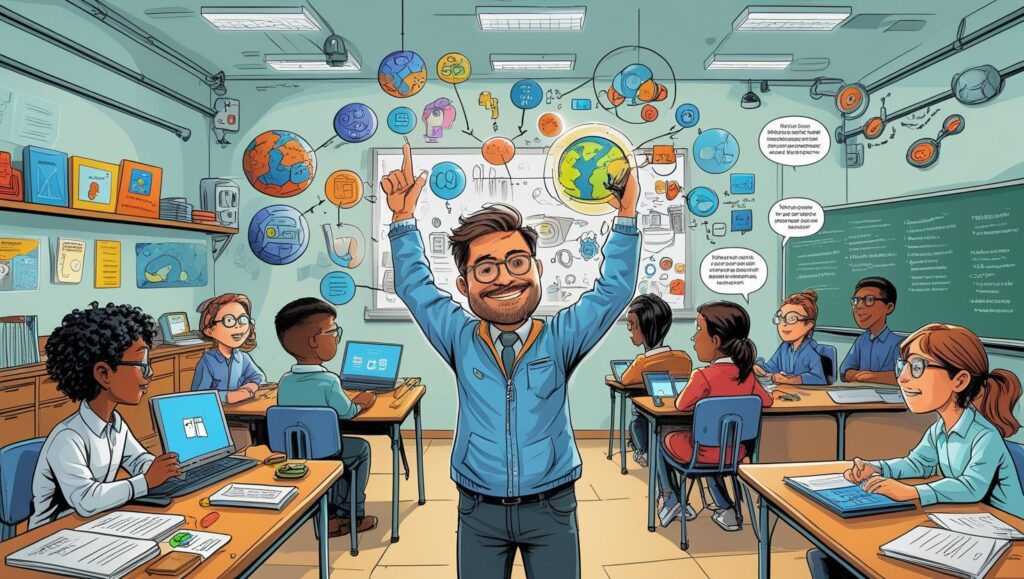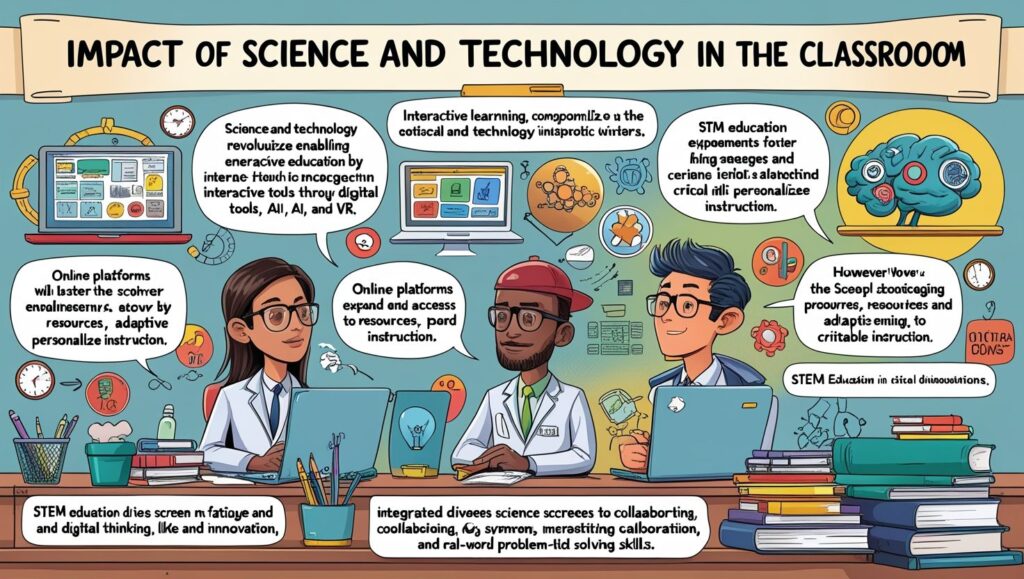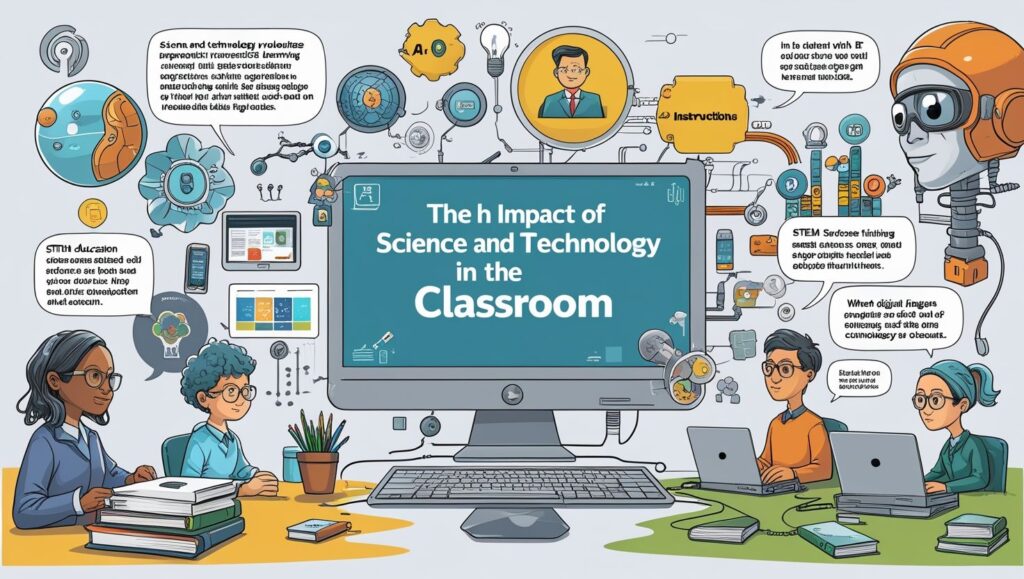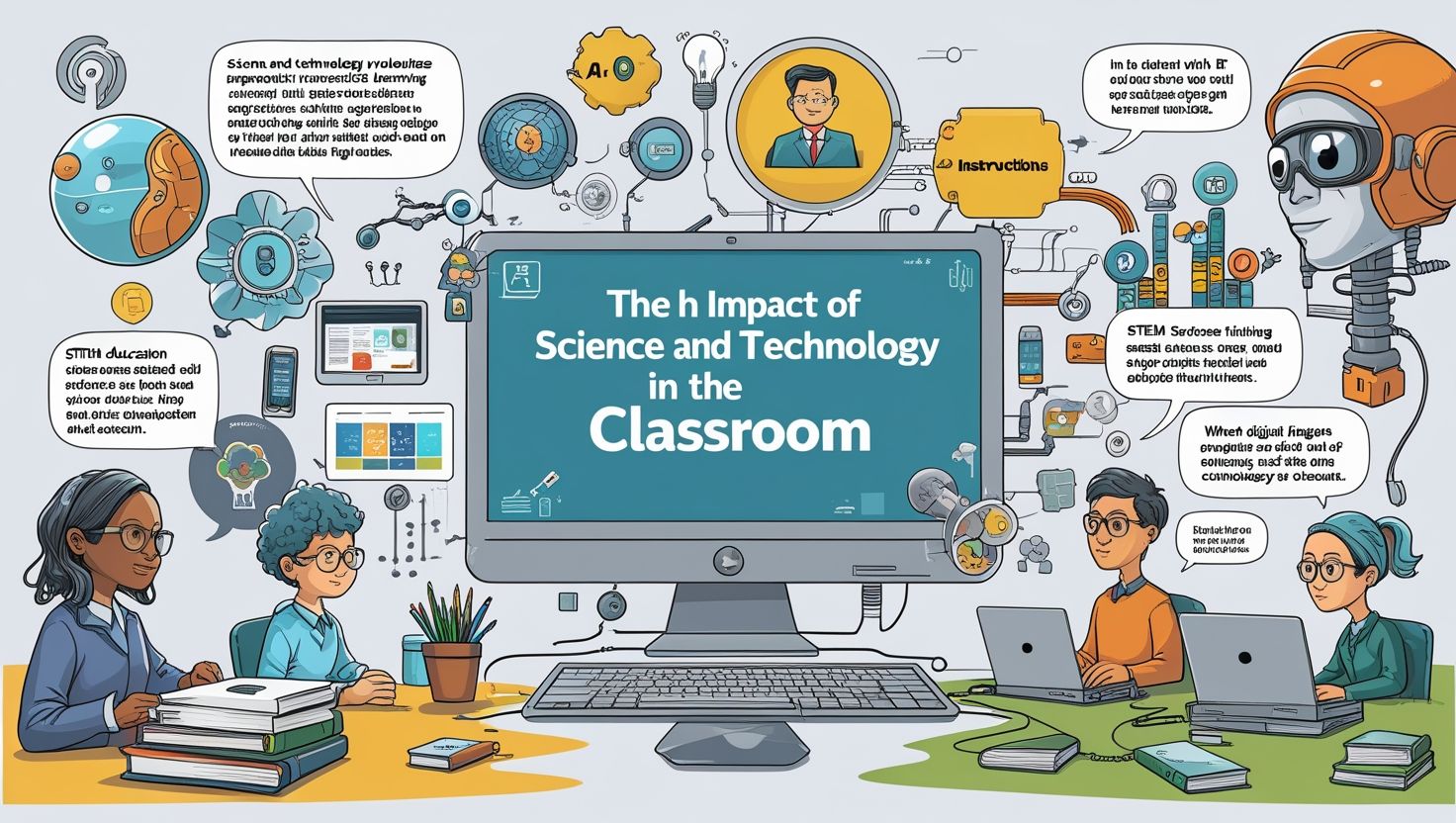Introduction
Impact of Science and Technology in the Classroom, In recent decades, science and technology have changed every aspect of life. The classroom is no exception. In fact, education has experienced a digital revolution. Today’s learners interact with content far differently than before. Traditional chalkboards are being replaced with digital screens. Printed textbooks are now shared alongside online materials.
Moreover, teachers now use multimedia tools to make lessons engaging. As a result, learning becomes more interactive and student-centered. Digital platforms allow students to explore topics deeply. Therefore, science and technology help promote critical thinking. In addition, educational software provides personalized learning. Students can progress at their own pace. Furthermore, technology enables real-time assessment. This helps teachers adjust instruction instantly.
However, the shift also demands new skills from teachers. They must learn to use new tools effectively. Training and support are crucial. Without it, technology may not be used properly. Despite challenges, the benefits are many. Science and technology, when applied well, can transform the learning experience. Thus, they play a vital role in modern classrooms.
Enhancing Student Engagement Through Technology
One of the biggest advantages of technology is improved student engagement. Learners today are digital natives. Therefore, they respond well to interactive tools. Smartboards, tablets, and apps capture their attention quickly. Instead of listening passively, students now participate actively.
In addition, educational games make learning fun. Subjects like math and science become less intimidating. As a result, students show more interest and motivation. Visuals and animations also help clarify complex concepts. Thus, abstract ideas become easier to understand.
Meanwhile, quizzes and polls provide instant feedback. This keeps students alert during lessons. Moreover, they can express opinions and thoughts easily. Interactive platforms like Kahoot or Quizizz make learning dynamic. However, teachers must balance entertainment with learning goals. Too much focus on games may distract students. Therefore, a proper strategy is essential. Tools should support learning objectives.
In conclusion, technology makes classrooms more engaging. When used well, it boosts attention and involvement. Students enjoy learning and stay focused longer. Hence, science and technology can significantly increase student participation in class.

Promoting Collaborative Learning
Science and technology encourage students to work together. Through digital tools, collaboration becomes easier and faster. Students can share documents online. They can also discuss ideas on forums or video calls. As a result, teamwork grows beyond the classroom walls.
For instance, platforms like Google Docs allow multiple users to edit at once. This promotes cooperation and peer learning. In addition, virtual classrooms support group discussions. Students can learn from each other’s perspectives.
Moreover, science projects become more effective with online research. Learners gather information and present it creatively. They may create slides, videos, or infographics. These tools improve communication and teamwork. However, some students may not participate equally. Teachers must ensure fair contribution. Therefore, roles should be assigned clearly. Monitoring tools can also help track participation.
In brief, technology builds stronger collaboration skills. Students work in groups more efficiently. They learn to listen, share, and respect different views. Consequently, they prepare for real-world teamwork. Thus, science and technology foster a more interactive and cooperative learning environment.
Facilitating Personalized Learning
Science and technology allow tailored instruction for every learner. Students learn at different speeds and styles. Therefore, one method cannot suit all. Technology addresses this challenge effectively.
For example, adaptive learning programs adjust content based on performance. Slow learners receive more practice. Advanced students move ahead without waiting. As a result, every student makes progress. In addition, learning becomes more satisfying.
Moreover, online tutorials and videos offer extra support. Students can review lessons anytime. Therefore, learning extends beyond the classroom. Audio and visual aids also help learners with different needs. Meanwhile, feedback systems guide students step-by-step. However, personalized learning needs constant monitoring. Teachers must track data and make adjustments. They also need training in digital tools. Without support, technology may confuse students.
Still, the benefits are clear. Personalized learning empowers students. It respects individual pace and ability. Consequently, learners gain confidence. They take responsibility for their learning. Thus, with the help of science and technology, classrooms become more inclusive. Every student receives the attention they need. That leads to better outcomes for all.

Access to Global Resources and Knowledge
Technology connects students to the world. No longer are learners limited to local textbooks. They can explore global resources in seconds. This opens new doors in education. For example, students can attend virtual museums. They can watch videos from NASA or MIT. As a result, learning becomes richer. Global knowledge adds depth to classroom topics.
In addition, e-books and journals are accessible online. Students stay updated with the latest discoveries. Therefore, science and technology foster lifelong learning. Meanwhile, platforms like Khan Academy or Coursera offer free lessons.
Moreover, cultural exchange becomes possible. Students can interact with peers worldwide. Through email or video chat, they share ideas and traditions. This builds global awareness and respect. However, not all students have equal access to the internet. Digital inequality is a major concern. Schools must ensure fair access to devices and connectivity.
Despite the challenges, global access enriches education. Students learn from experts and peers worldwide. Consequently, they develop broad perspectives. Thus, science and technology break classroom walls and make the world their learning space.
Improving Assessment and Evaluation
Assessing students is vital in education. With technology, this process becomes easier and faster. Teachers can check progress instantly. Therefore, they can modify teaching quickly to meet needs. Digital quizzes and assignments save time. Results are generated automatically. As a result, teachers get data quickly. This helps them identify strengths and weaknesses.
Moreover, online platforms allow continuous assessment. Students can be tested regularly in smaller portions. This reduces exam pressure. In addition, performance trends are easy to track. Teachers can give timely feedback. Furthermore, students receive personalized reports. They know exactly what to improve. This makes learning more focused. Self-assessment tools also encourage reflection. Learners take control of their progress.
However, over-reliance on digital tests may ignore creativity. Not all skills can be measured online. Therefore, teachers should combine traditional and digital methods. In conclusion, technology enhances the assessment process. It makes evaluation faster, deeper, and more meaningful. Both students and teachers benefit. Thus, science and technology strengthen the foundation of effective learning.
Supporting Teachers’ Professional Development
Teachers are key to successful classrooms. Technology helps them grow continuously. With online tools, they can update skills easily. Therefore, they remain effective and current. Professional development courses are widely available. Platforms like Coursera and Edmodo offer training. As a result, teachers gain knowledge from global experts. Webinars and forums also provide support.
In addition, teaching communities share best practices. Teachers can learn from one another. They discuss challenges and find solutions. Consequently, collaboration grows among educators. Moreover, teaching becomes more flexible. Teachers can learn at their own pace. They can revisit lessons anytime. This supports deep learning and understanding.
However, some teachers resist change. They may fear new tools. Therefore, schools must provide guidance. Regular workshops and tech support are essential. Still, the impact is clear. With ongoing learning, teachers become more confident. They try new methods and improve instruction. Ultimately, students benefit the most. Thus, science and technology empower teachers. They grow professionally and stay inspired. This ensures quality education for every learner.
Creating Inclusive Learning Environments
Inclusive education ensures all students learn together. Science and technology play a key role here. They support learners with different needs. For instance, screen readers help visually impaired students. Speech-to-text tools assist those with writing difficulties. As a result, learning becomes accessible. No one feels left out.
Moreover, multimedia aids make content clearer. Videos, charts, and audio support various learning styles. Therefore, students understand better. Those with attention issues stay engaged longer. In addition, digital platforms allow flexible learning. Students can pause, rewind, or skip content. This is especially helpful for learners with disabilities.
Meanwhile, teachers can monitor progress individually. They adjust lessons for each learner. Collaboration tools also promote peer interaction. Everyone participates actively. However, inclusion needs planning. Tools must be chosen carefully. Teachers must be trained in their use. Without proper support, inclusion may fail. Despite challenges, the benefits are great. Science and technology bridge learning gaps. They bring equality into classrooms. Therefore, inclusive education becomes a reality.

Challenges and Limitations of Classroom Technology
While benefits are many, challenges also exist. Technology in classrooms is not always smooth. Therefore, understanding limitations is important. Firstly, not all schools have equal access. Rural areas may lack internet or devices. This creates a digital divide. As a result, some students fall behind.
Secondly, overuse of screens may harm health. Eyestrain, poor posture, and lack of physical activity are concerns. In addition, some students become addicted to devices. Moreover, technology may distract learners. Social media and games interfere with focus. Therefore, teachers must manage usage strictly. Parental control and monitoring tools help.
Another issue is technical problems. Devices may crash or lag. This disrupts lessons. Teachers need backup plans. They must stay calm and flexible. Furthermore, not all teachers are tech-savvy. Some may resist change. Training programs must be ongoing. Support should be available at all times.
In short, technology has drawbacks too. But with planning and support, these can be overcome. Schools must balance digital tools with traditional methods. This creates a safe and effective learning space.
Future Outlook and Conclusion
Science and technology will continue to evolve. Therefore, education must keep pace. Future classrooms will be even more digital. Artificial intelligence and virtual reality are already in use. These tools will grow in popularity. Moreover, personalized learning will become smarter. AI will guide students in real time. Teachers will act more as facilitators. Meanwhile, global learning will expand. Students will learn from international mentors.
In addition, data will guide instruction. Teachers will know what each student needs. This will improve outcomes. Education will become more precise and effective. However, ethical concerns may arise. Data privacy, equity, and screen time must be managed. Therefore, policies will be essential. Governments and schools must work together.
To conclude, science and technology are transforming education. They make learning engaging, personalized, and global. Despite some challenges, their impact is mostly positive. When used wisely, these tools uplift both teachers and learners. Hence, classrooms powered by science and technology are the future. They prepare students for tomorrow’s world. The journey is ongoing, but the direction is clear.

Keep writing! Your content is always so helpful.
Excellent work! Looking forward to future posts.
Your passion for the topic really shines through.
Excellent work! Looking forward to future posts.
Thank you for covering this so thoroughly. It helped me a lot.
I always look forward to your posts. Keep it coming!
Such a simple yet powerful message. Thanks for this.
The way you write feels personal and authentic.
This content is really helpful, especially for beginners like me.
You’ve sparked my interest in this topic.
I appreciate the honesty and openness in your writing.
Such a simple yet powerful message. Thanks for this.
I like how you kept it informative without being too technical.
I agree with your point of view and found this very insightful.
You’ve done a great job with this. I ended up learning something new without even realizing it—very smooth writing!
Thanks for sharing your knowledge. This added a lot of value to my day.
Thank you for putting this in a way that anyone can understand.
Your writing style makes complex ideas so easy to digest.
This gave me a whole new perspective. Thanks for opening my eyes.
What a great resource. I’ll be referring back to this often.
Thanks for taking the time to break this down step-by-step.
This topic is usually confusing, but you made it simple to understand.
You really know how to connect with your readers.
I appreciate your unique perspective on this.
Thank you for being so generous with your knowledge.
Thanks for making this easy to understand even without a background in it.
Thank you for covering this so thoroughly. It helped me a lot.
I love how practical and realistic your tips are.
I’ve bookmarked this post for future reference. Thanks again!
You’ve clearly done your research, and it shows.
I’ve read similar posts, but yours stood out for its clarity.
Thank you for putting this in a way that anyone can understand.
I like how you presented both sides of the argument fairly.
I learned something new today. Appreciate your work!
I enjoyed your perspective on this topic. Looking forward to more content.
I enjoyed your perspective on this topic. Looking forward to more content.
Thanks for making this easy to understand even without a background in it.
I like how you presented both sides of the argument fairly.
Thank you for covering this so thoroughly. It helped me a lot.
Such a refreshing take on a common topic.
This is exactly the kind of content I’ve been searching for.
You clearly know your stuff. Great job on this article.
This made me rethink some of my assumptions. Really valuable post.
Your writing style makes complex ideas so easy to digest.
You always deliver high-quality information. Thanks again!
You write with so much clarity and confidence. Impressive!
You’ve done a great job with this. I ended up learning something new without even realizing it—very smooth writing!
Such a thoughtful and well-researched piece. Thank you.
You explained it in such a relatable way. Well done!
You have a real gift for explaining things.
Your writing style makes complex ideas so easy to digest.
Thank you for offering such practical guidance.
I love how well-organized and detailed this post is.
I always look forward to your posts. Keep it coming!
Your content never disappoints. Keep up the great work!
Keep educating and inspiring others with posts like this.
Thank you for being so generous with your knowledge.
I enjoyed your take on this subject. Keep writing!
This gave me a whole new perspective. Thanks for opening my eyes.
I like how you presented both sides of the argument fairly.
This is now one of my favorite blog posts on this subject.
I wasn’t expecting to learn so much from this post!
Thank you for being so generous with your knowledge.
You really know how to connect with your readers.
You’ve done a great job with this. I ended up learning something new without even realizing it—very smooth writing!
This gave me a whole new perspective. Thanks for opening my eyes.
You always deliver high-quality information. Thanks again!
Great job simplifying something so complex.
I love how well-organized and detailed this post is.
This post cleared up so many questions for me.
I’ll definitely come back and read more of your content.
The way you write feels personal and authentic.
I appreciate the depth and clarity of this post.
You’re doing a fantastic job with this blog.
Your tips are practical and easy to apply. Thanks a lot!
I feel more confident tackling this now, thanks to you.
I like how you kept it informative without being too technical.
I appreciate how genuine your writing feels. Thanks for sharing.
You have a real gift for explaining things.
This was really well done. I can tell a lot of thought went into making it clear and user-friendly. Keep up the good work!
This post gave me a new perspective I hadn’t considered.
I never thought about it that way before. Great insight!
It’s great to see someone explain this so clearly.
It’s great to see someone explain this so clearly.
Such a refreshing take on a common topic.
It’s refreshing to find something that feels honest and genuinely useful. Thanks for sharing your knowledge in such a clear way.
This gave me a whole new perspective. Thanks for opening my eyes.
I appreciate the depth and clarity of this post.
It’s refreshing to find something that feels honest and genuinely useful. Thanks for sharing your knowledge in such a clear way.
I love how well-organized and detailed this post is.
Your writing always inspires me to learn more.
Thank you for putting this in a way that anyone can understand.
This was a very informative post. I appreciate the time you took to write it.
I wish I had read this sooner!
Posts like this are why I keep coming back. It’s rare to find content that’s simple, practical, and not full of fluff.
I’ll definitely come back and read more of your content.
This topic is usually confusing, but you made it simple to understand.
I learned something new today. Appreciate your work!
I love how clearly you explained everything. Thanks for this.
This made me rethink some of my assumptions. Really valuable post.
You’ve done a great job with this. I ended up learning something new without even realizing it—very smooth writing!
I appreciate your unique perspective on this.
This topic is usually confusing, but you made it simple to understand.
This helped clarify a lot of questions I had.
Great job simplifying something so complex.
This is one of the best explanations I’ve read on this topic.
I hadn’t considered this angle before. It’s refreshing!
Your writing always inspires me to learn more.
What I really liked is how easy this was to follow. Even for someone who’s not super tech-savvy, it made perfect sense.
Very relevant and timely content. Appreciate you sharing this.
This is exactly the kind of content I’ve been searching for.
What a helpful and well-structured post. Thanks a lot!
Such a simple yet powerful message. Thanks for this.
You clearly know your stuff. Great job on this article.
You have a real gift for explaining things.
I’ve bookmarked this post for future reference. Thanks again!
I love the clarity in your writing.
This was easy to follow, even for someone new like me.
This is one of the best explanations I’ve read on this topic.
buxw9e
Your thoughts are always so well-organized and presented.
Thanks for making this so reader-friendly.
077cms
py5p6v
4cris8
It is in reality a nice and helpful piece of info. I’m satisfied that you simply shared this helpful information with us. Please stay us informed like this. Thank you for sharing.
Доброго!
Долго не спал и думал как встать в топ поисковиков и узнал от гуру в seo,
крутых ребят, именно они разработали недорогой и главное top прогон Xrumer – https://www.bing.com/search?q=bullet+%D0%BF%D1%80%D0%BE%D0%B3%D0%BE%D0%BD
Линкбилдинг seo помогает достигать лучших результатов. Он включает создание ссылок и работу с трастовыми площадками. Программы для автоматизации ускоряют процесс. Чем больше качественных ссылок, тем выше позиции. Линкбилдинг seo – залог успешного продвижения.
продвижение сайтов новороссийск, бесплатно программу для продвижения сайта, линкбилдинг на форумах
многоуровневый линкбилдинг, интернет магазин битрикс seo, настроить сео на тильде
!!Удачи и роста в топах!!
Привет всем!
Долго не мог уяснить как поднять сайт и свои проекты и нарастить CF cituation flow и узнал от успещных seo,
энтузиастов ребят, именно они разработали недорогой и главное лучший прогон Xrumer – https://www.bing.com/search?q=bullet+%D0%BF%D1%80%D0%BE%D0%B3%D0%BE%D0%BD
Увеличение трафика с помощью прогона возможно через массовое размещение ссылок. Форумы и блоги дают естественные линкбэксы. Xrumer ускоряет процесс автоматизации. Чем больше качественных ссылок, тем выше DR. Увеличение трафика с помощью прогона помогает SEO-продвижению.
услуги seo аудит сайта, seo поисковое продвижение сайтов, Как сделать прогон сайта через Xrumer
Рассылки с помощью Xrumer, tabs seo, простор сео
!!Удачи и роста в топах!!
Привет всем!
Долго не спал и думал как встать в топ поисковиков и узнал от друзей профессионалов,
топовых ребят, именно они разработали недорогой и главное продуктивный прогон Xrumer – https://www.bing.com/search?q=bullet+%D0%BF%D1%80%D0%BE%D0%B3%D0%BE%D0%BD
Xrumer: советы и трюки помогают эффективно использовать программу. Автоматизация ускоряет процесс линкбилдинга. Массовый прогон повышает DR и позиции сайта. Следование рекомендациям специалистов улучшает результат. Xrumer: советы и трюки полезны новичкам и профессионалам.
seo роль социальных сетей, ручное продвижение сайт, Автоматический постинг форумов
Повышение авторитетности сайта, счет за продвижение сайта, сео комплекс сайт
!!Удачи и роста в топах!!